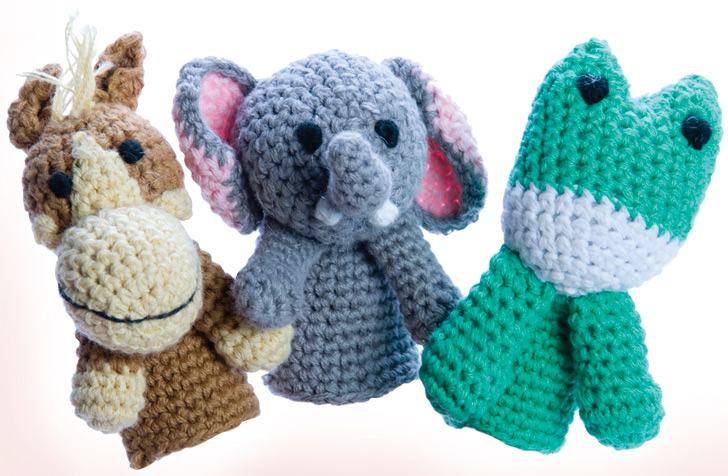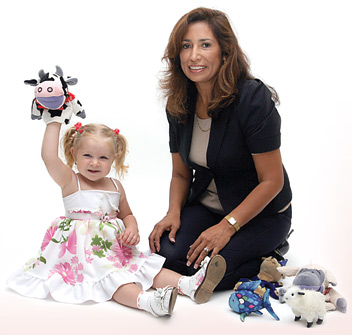The Puppet Master
When it comes to therapy, doctoral student Sue Butler proves puppets are more than just child’s play
(Article from Barry Magazine 2009 by Elizabeth Hanly)
She hardly ever travels without a big brown bug and a very ugly frog. And travel she does. Family therapist and Barry doctoral student Sue Butler visits many of her clients in their own homes - never arriving without a whole array of puppets, particularly when there is a small child in the house. She finds it’s the best way to get down to basics.
Small children aged 3 to 8 typically do not participate in family therapy because the vast majority of therapists consider such children too young to articulate their feelings or understand complex patterns of behavior. Butler thinks otherwise, as she perfects her skills using an approach called narrative therapy.
Often described as “post-modern,” narrative therapy allows clients to put away old, tired versions of the stories they tell themselves [and everybody else] about their lives. Playing more to the clients’ strengths than their weaknesses, the approach urges clients to see themselves as much more than the presenting problem and to identify ways in which they are already taking steps to solve it – even if they don’t fully realize it. There are no victims in narrative therapy. There may be talk, but there is no blame or endless repetition of old grievances.
But what does something so conceptual have to do with children? Children, after all, are dealing with feelings that are often too big, too complex for them to name. Enter the puppets.
When Butler arrives at a home where a small child is a family’s “presenting issue”, i.e., the member who is the apparent cause of the disruption in the family, she will ask not only the child, but all family members to join her and the puppets on the floor.
Butler sees a “presenting issue” as just that: a flag indicating the family dynamics are off kilter. She regards her work as realigning the dynamics of the entire family. So there on the floor, Butler talks to a child.
“I understand that you have been fighting with Bobby at school,” Butler may tell a child whose parents are weary after too many unproductive parent-teacher meetings.
Butler then asks the child to choose a puppet, one that defines the presenting problem, or in “little kid speak,” one that looks like “fighting with Bobby.” Invariably the frog or another of the “mean, ugly” puppets is chosen. Butler will ask the puppet’s name. Bobby says the puppet’s name is “Scary.”
Butler will ask when “Scary” comes to the child. “When there is shouting” is the answer, as Bobby’s parents remember all the shouting that has gone on at home, as well. Butler asks when “Scary” is not with the child, or when the child has been able to push “Scary” away. “When I am drawing,” the child replies.
With this seemingly simple conversation, Butler has helped the child see that “Scary” is outside of him, that “Scary” is a particular situation, with particular cues, not a feeling big enough and omnipresent enough to gobble him up whole. The child is now in a relationship with “Scary” and does not have to fall victim to all of “Scary’s” suggestions. The child has also identified a space that is safe from “Scary.” Meanwhile, the parent, who has been witness to this, is learning how to speak the emotional language of the child.
Rainbow-colored fish count too
Butler is not the first to use puppets in therapy with small children, but most often a therapist uses them either in play-therapy – a child doll may rage at a mommy doll – or as a kind of wry or winsome Muppetesque co-therapist. “Butler has made a breakthrough in using the puppet as, quite literally, the problem, a problem that children and their families can then converse with,” says Assistant Professor of Counseling Dr. Jeffrey Guterman, who is Butler’s academic advisor.
Narrative therapy has its roots in the 1990s work of Australian family therapist Michael White, who theorized that in order to move beyond present dilemmas, an individual must move past identification with them. In effect, we need to be able to change the story lines we tell ourselves in order to tell ourselves new, more positive stories about our lives. As Associate Professor of Counseling Dr. James Rudes puts it, “Externalizing a problem frees people up. They begin to see they are more than that problem.”
Not surprisingly then, when Butler makes her house calls, she not only brings frogs and bugs but also rainbow-colored fish, baby elephants, pink kitty cats and many more critters. The children are asked to pick puppets who are them, as well as the puppet who is the issue. “Those pink baby kittens are a real hit with the little girls,” Butler says.
“Butler has found an object – the puppets – that does the very thing that the narrative therapy model attempts to do conceptually,” Guterman says, adding that Butler’s approach allows children to see themselves as three-dimensional and, therefore, as “far more than only problematic.”
And, although Guterman says he has mentored a number of outstanding doctoral students at Barry, he is quick to note that he has “never encountered one whose approach is as creative or significant as [Butler’s].” In fact, Guterman and Rudes recently collaborated with Butler on an article describing her work in the July ’09 issue of the prestigious Journal of Mental Health Counseling.
Rudes says he also looks forward to the time when puppets will become regulars at Barry’s Dr. Maureen Duffy Family Enrichment Center where master’s and doctoral students – some of them mentored by Butler – provide therapy to families from the greater North Miami community.
“Part of what is remarkable about her work is the range of issues she and her puppets take on,” Rudes notes. “With this approach there is little room for a child’s embarrassment or fear or confusion. Instead, a child’s own imagination leads the way to a solution.” As an example, Rude cites a case of a child with incontinence issues who named a puppet “Sneaky Poop.” When did “Sneaky Poop” come? When did it stay away?
“Ask the puppets,” Rudes says.
Little people, big insights
Even when Butler is working with an older child or teen as the “identifying” problem in a family’s therapy, she feels the voices of the other children must be heard as well, and by the entire family. “The words of a family’s younger members can be far more healing than is widely recognized,” she explains.
Suppose, for example, that the parents in a family and their teenage daughter frequently argue – loudly. Once again Butler brings out the puppets and invites the entire family to sit with her on the floor. A far younger sibling chooses a puppet who is what the child feels when anger permeates the entire household. Butler will ask the child the puppet’s name. “So sad” may be the answer, or “I love my sister.”
“Often parents or elder siblings have no idea how their relationship with one another can affect the feelings of the quiet, out-of-the-line-of-fire family member, Butler says. “It is through all such steps [and by getting every family member involved] that a family’s dynamics can truly change. I have yet to meet a parent, who, even in the most extreme circumstances, doesn’t want to help their child.”
Butler sits back for a moment. “Sometimes I even invite the dog in,” she says with a grin.
Traveling without baggage
Butler knows just how good family life can be. Growing up in Peru, she recalls, "Kids were included in every party, and everybody would dance through the night.”
But when she came to the United States in her late teens to study, she found herself alone, without the benefit of the large family support system she had always enjoyed.
“Perhaps the juxtaposition of what I had known and what I lived, underlined the importance of family for me,” says Butler, who married her husband of 26 years soon after arriving in Miami. Although she has spent much of the past two decades raising three children, she says she never remembers a time when she didn’t know that she would go back to school. To work as a family therapist was always her goal.
While studying first as a master’s candidate at Nova Southeastern University then for her doctorate at Barry, Butler was “concerned about the lack of viable treatment models for very young children.” She also wanted to develop an approach that accommodated the multicultural issues that she felt had been largely ignored or misinterpreted by the therapeutic community in general.
Since narrative therapy requires less direct input from the therapist, Butler notes, multicultural wires are much less likely to get crossed: “It asks the clients, with minimal interference from the therapist, to identify what is already working in their lives.”
There is always the danger,” Guterman adds, of a therapist “layering another set of cultural expectations on top of the client and thus interfering with the healing process.” The therapeutic literature is only beginning to acknowledge these issues, he notes, all of which makes the insights from communities like South Florida so important.
Banishing white angels (and other demons) from the dinner table
Although Butler may feel her special calling is working with very young children, she is also interested in the potential of narrative therapy for teens. “She especially enjoyed working with many of our most complicated cases,” says Elizabeth Johnson L.M.F.T., who supervised Butler during her internship at Steps, a Broward outpatient program at Memorial Regional Hospital. Johnson cites a case in which Butler used narrative therapy to get a teenage girl to see herself as separate from the gang she was deeply involved with.
In fact, Butler now runs several groups for teens at Broward’s Gulf Coast Community Center. Sometimes the puppets come out, while other times she uses other strategies she has developed, such as, “Whose coming to dinner?”
In this exercise she asks the teens to draw an image of the “thing” that has brought them into therapy. She sees a lot of white angels, veiled references to cocaine. Butler then works with the teens until eventually she has them drawing, talking and imagining the white angel taking their place at the dinner table: “Oh look, there’s no room left for you anymore - nope, no room at all.” She pushes the paradigm even further. “You know that one dish that your mom makes just for you, the one you love more than anything, oops, gone. The angel is wolfing that down too.”
Butler says she has seen so much improvement in these kids that she is now writing about strategies to most effectively use narrative therapy in group work.
“I look around at all the kids,” she says. “I want to do what I can to stop the hurt.”

|








